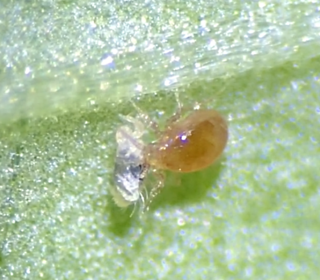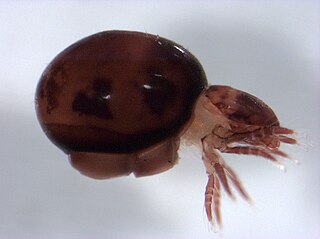
Scabies is a contagious skin infestation by the mite Sarcoptes scabiei. The most common symptoms are severe itchiness and a pimple-like rash. Occasionally, tiny burrows may appear on the skin. In a first-ever infection, the infected person usually develops symptoms within two to six weeks. During a second infection, symptoms may begin within 24 hours. These symptoms can be present across most of the body or just certain areas such as the wrists, between fingers, or along the waistline. The head may be affected, but this is typically only in young children. The itch is often worse at night. Scratching may cause skin breakdown and an additional bacterial infection in the skin.

Arachnida is a class of joint-legged invertebrate animals (arthropods), in the subphylum Chelicerata. Arachnida includes, among others, spiders, scorpions, ticks, mites, pseudoscorpions, harvestmen, camel spiders, whip spiders and vinegaroons.

Mites are small arachnids. Mites span two large orders of arachnids, the Acariformes and the Parasitiformes, which were historically grouped together in the subclass Acari. However, most recent genetic analyses do not recover the two as each other's closest relative within Arachnida, rendering the group non-monophyletic. Most mites are tiny, less than 1 mm (0.04 in) in length, and have a simple, unsegmented body plan. The small size of most species makes them easily overlooked; some species live in water, many live in soil as decomposers, others live on plants, sometimes creating galls, while others again are predators or parasites. This last type includes the commercially destructive Varroa parasite of honey bees, as well as scabies mites of humans. Most species are harmless to humans, but a few are associated with allergies or may transmit diseases.

House dust mites are various species of acariform mites belonging to the family Pyroglyphidae that are found in association with dust in dwellings. They are known for causing allergies.

Tetranychus urticae is a species of plant-feeding mite generally considered to be a pest. It is the most widely known member of the family Tetranychidae or spider mites. Its genome was fully sequenced in 2011, and was the first genome sequence from any chelicerate.

Spider mites are members of the Tetranychidae family, which includes about 1,200 species. They are part of the subclass Acari (mites). Spider mites generally live on the undersides of leaves of plants, where they may spin protective silk webs, and can cause damage by puncturing the plant cells to feed. Spider mites are known to feed on several hundred species of plants.

Mange is a type of skin disease caused by parasitic mites. Because various species of mites also infect plants, birds and reptiles, the term "mange", or colloquially "the mange", suggesting poor condition of the skin and fur due to the infection, is sometimes reserved for pathological mite-infestation of nonhuman mammals. Thus, mange includes mite-associated skin disease in domestic mammals, in livestock, and in wild mammals. Severe mange caused by mites has been observed in wild bears. Since mites belong to the arachnid subclass Acari, another term for mite infestation is acariasis.

Bat-Mite is a fictional character appearing in American comic books published by DC Comics. Bat-Mite is an imp similar to the Superman villain Mister Mxyzptlk. Depicted as a small, childlike man in an ill-fitting Batman costume, Bat-Mite possesses what appear to be near-infinite magical powers, but he actually uses highly advanced technology from the fifth dimension that cannot be understood by humans' limited three-dimensional views. Unlike Mxyzptlk, Bat-Mite idolizes his superhero target and thus he has visited Batman on various occasions, often setting up strange and ridiculous events so that he could see his hero in action. Bat-Mite is more of a nuisance than a supervillain, and often departs of his own accord upon realizing that he has angered his idol.

Varroa destructor, the Varroa mite is an external parasitic mite that attacks and feeds on the honey bees Apis mellifera and Apis cerana. The disease caused by the mite in this genus is called varroosis.

Acaricides are pesticides that kill members of the arachnid subclass Acari, which includes ticks and mites. Acaricides are used both in medicine and agriculture, although the desired selective toxicity differs between the two fields.

The Acariformes, also known as the Actinotrichida, are the more diverse of the two superorders of mites. Over 32,000 described species are found in 351 families, with an estimated total of 440,000 to 929,000 species, including undescribed species.

Parasitiformes are a superorder of Arachnids, constituting one of the two major groups of mites, alongside Acariformes. Parasitiformes has, at times, been classified at the rank of order or suborder.

Rajko Mitić was a Serbian footballer, coach, executive and journalist.

The Phytoseiidae are a family of mites which feed on thrips and other mite species. They are often used as a biological control agent for managing mite pests. Because of their usefulness as biological control agents, interest in Phytoseiidae has steadily increased over the past century. Public awareness of the biological control potential of invertebrates has been growing, though mainly in the US and Europe. In 1950, there were 34 known species. Today, there are 2,731 documented species organized in 90 genera and three subfamilies.

Oribatida, also known as oribatid mites, moss mites or beetle mites, are an order of mites, in the "chewing Acariformes" clade Sarcoptiformes. They range in size from 0.2 to 1.4 millimetres. There are currently 12,000 species that have been identified, but researchers estimate that there may be anywhere from 60,000 to 120,000 total species. Oribatid mites are by far the most prevalent of all arthropods in forest soils, and are essential for breaking down organic detritus and distributing fungi.

Psoroptidia is a parvorder of the Acari (mite) group Astigma. It comprises around 40 families, and apparently originated as parasites of birds, before a secondary radiation saw some taxa become parasites of mammals. Because of their parasitic lifestyle, members of the Psoroptidia do not exhibit a deutonymph stage.

The Prostigmata is a suborder of mites belonging to the order Trombidiformes, which contains the "sucking" members of the "true mites" (Acariformes).

Trombiculidae ; commonly referred to in North America as chiggers and in Britain as harvest mites, but also known as berry bugs, bush-mites, red bugs or scrub-itch mites, are a family of mites. Chiggers are often confused with jiggers – a type of flea. Several species of Trombiculidae in their larva stage bite their animal or human host and by embedding their mouthparts into the skin cause "intense irritation" or "a wheal, usually with severe itching and dermatitis".
Dragutin Mitić was a tennis player from Yugoslavia. He defected to the West in 1952 and afterwards lived in the United States.

The Trombidiformes are a large, diverse order of mites.
















